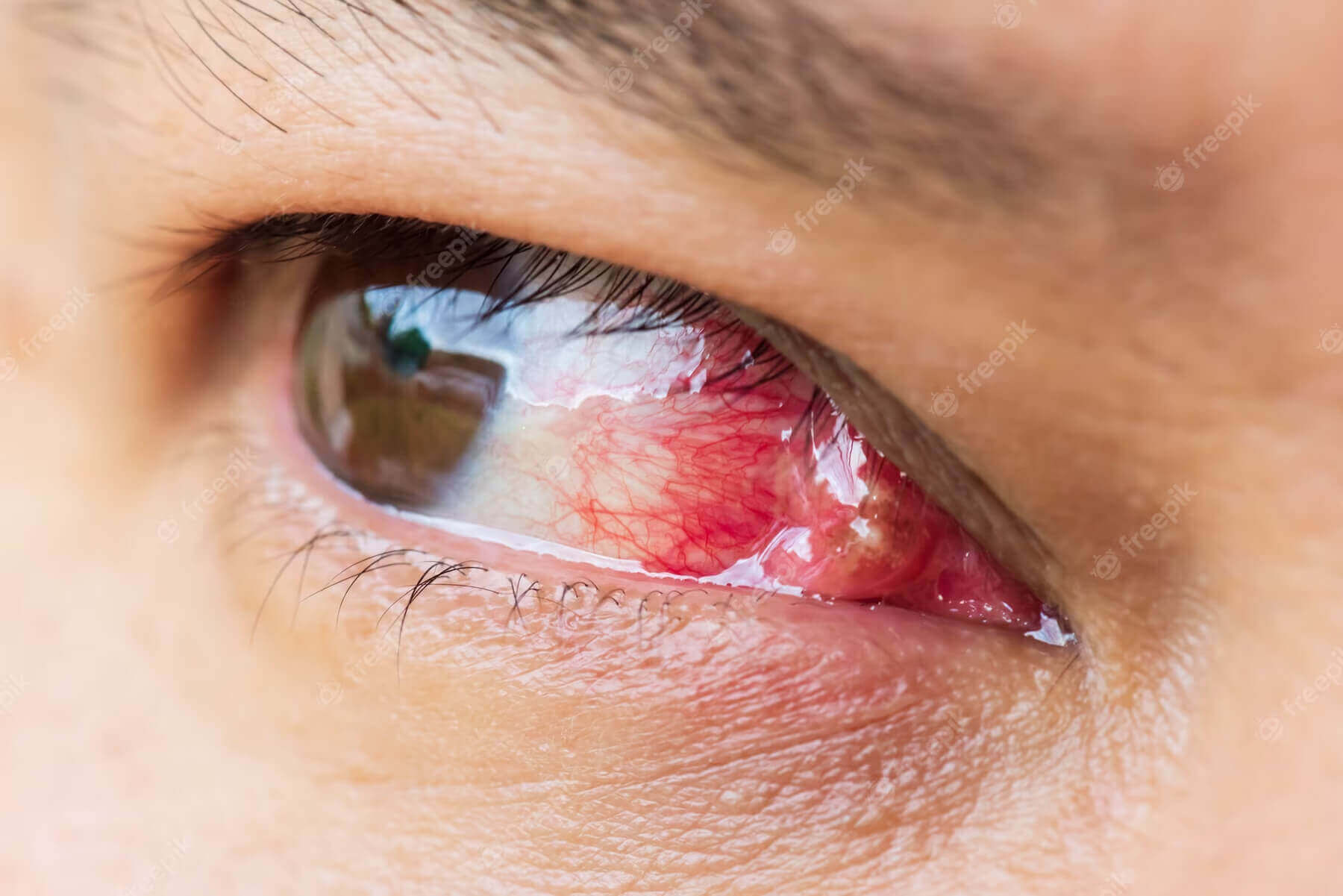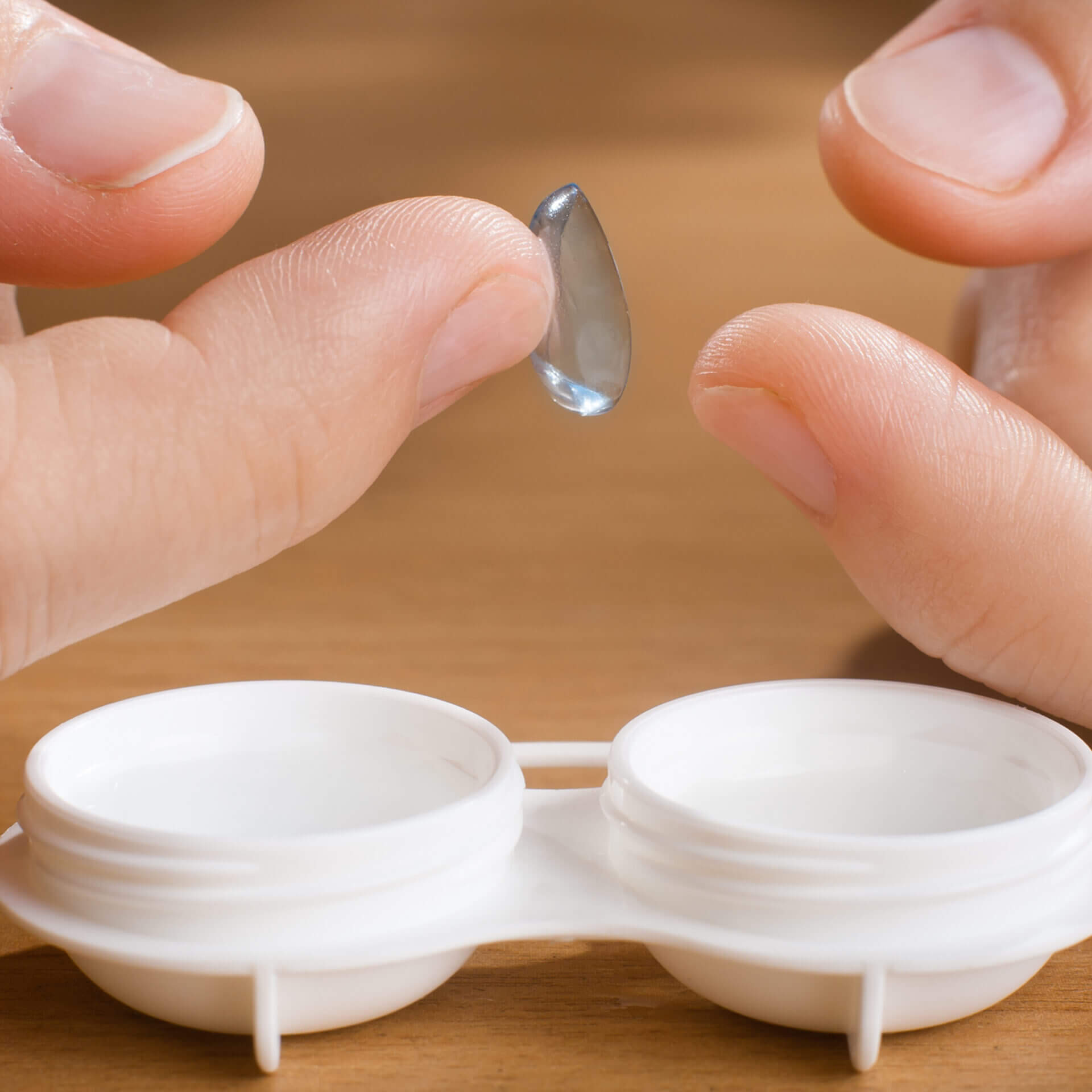Hypoxia-Making sure your eyes get enough oxygen
If you sleep with your contact lenses you might also experience something called hypoxia, which is when your eyes lack oxygen, causing them to swell and begin to grow new blood vessels, which can really affect your vision. In general, our eyes obtain oxygen from the air around us. However, when we put a contact lens over our eye, the amount of oxygen that can get into the eye is reduced. Therefore, it is extremely important to use a contact lens that has a high oxygen permeability. This is also why it is extremely important that you get a contact lens exam before purchasing contact lenses. Because that exam will make sure that your eye doctor is giving you contact lenses that are fitting properly on your eyes. A good fit means that the contact lens is not too tight, and that you have the right type of lens, meaning you have a lens that allows for a lot of oxygen permeability, which will reduce problems of this sort. Sleeping with contact lenses in your eye may cause your eyes to swell the next morning and cause hazy vision. It is therefore important to remove your contact lenses before going to bed.
Even if you are following these instructions, it is recommended that you allow for some time during the evening or one day per week when you wear glasses instead of contact lenses. This allows for your eyes to get more oxygen, further reducing your risk of hypoxia.
Ocular hypoxia in the eye can lead to symptoms such as:
- Blurry Vision: A common symptom of ocular hypoxia is blurry or distorted vision. The reduced oxygen supply can affect the eye's ability to focus properly.
- Eye Discomfort: Some individuals may experience eye discomfort, a gritty sensation, or dryness due to hypoxia.
- Photophobia: Increased sensitivity to light, known as photophobia, can occur as a result of ocular hypoxia.
- Redness: Ocular hypoxia can sometimes lead to red or bloodshot eyes.
Ocular hypoxia can lead to more significant long term damage such as:
- Cell Damage: Prolonged or severe hypoxia can damage the cells in the eye, including the cornea and retina. This can lead to impaired vision or even permanent vision loss.
- Corneal Edema: Hypoxia can cause the cornea to swell, resulting in corneal edema. This can blur vision and cause discomfort.
- Retinal Ischemia: In severe cases, hypoxia can affect the retina, potentially leading to retinal ischemia, a condition where the retina doesn't receive enough oxygen. This is a serious issue that can cause vision loss.
- Corneal Vascularization: Ocular hypoxia can trigger the growth of abnormal blood vessels into the cornea, known as corneal vascularization. This condition can obstruct light transmission through the cornea and lead to visual impairment.
- Macular Edema: In severe cases of ocular hypoxia, the macula, the central part of the retina responsible for detailed vision, can develop edema (swelling). This can lead to a condition called macular edema, which can significantly impair central vision.
- Optic Nerve Damage: Chronic or severe ocular hypoxia can harm the optic nerve, which carries visual information from the eye to the brain. Optic nerve damage can result in irreversible vision loss.
Corneal Vascularization
Corneal vascularization is the growth of new blood vessels into the transparent cornea of the eye, which is normally avascular. One study showed an increase of 24% risk for corneal vascularization from extended wear of contact lenses. Corneal vascularization can lead to vision impairment due to the obstruction of light transmission through the cornea. It can also lead to corneal edema, or swelling of the cornea
Corneal vascularization can lead to symptoms such as:
- Redness: One of the most noticeable symptoms is the appearance of red or bloodshot eyes. This redness is due to the presence of new blood vessels in the normally clear cornea.
- Blurry Vision: Corneal vascularization can disrupt the normal transparency of the cornea, leading to blurry or hazy vision.
- Discomfort: Some individuals may experience eye discomfort or a foreign body sensation due to the presence of these abnormal blood vessels.
- Sensitivity to Light: Increased sensitivity to light (photophobia) can occur as a result of corneal vascularization.
Corneal vascularization can lead to more significant long term damage such as:
- Visual Impairment: When new blood vessels grow into the cornea, they can obstruct light transmission, leading to visual impairment.
- Corneal Scarring: In severe cases, corneal vascularization can cause corneal scarring. This scarring can further impact vision quality and is often more challenging to treat.
Corneal Edema
If you imagine your cornea, the clear front part of your eyes as a delicate balloon filled with water, then corneal edema is when that balloon swells in size. This can be caused by corneal vascularization, when your eyes create new blood vessels due to stress, which then causes swelling. It can also be caused by hypoxia, or lack of oxygen, which in turn may stress the eye and prevent the corneal endothelium, responsible for pumping excess water out of the cornea, to stop working properly. When it becomes less efficient in removing water, this in turn causes fluid to accumulate within the cornea.
Corneal edema can lead to symptoms such as:
- Blurry Vision: One of the most common symptoms of corneal edema is blurry vision. The swelling of the cornea disrupts its clarity, leading to visual distortion.
- Halos and Glare: Some people with corneal edema may experience halos or glare, especially when looking at bright lights at night.
- Eye Discomfort: Corneal edema can cause eye discomfort, including a feeling of fullness or pressure in the eye.
- Sensitivity to Light: Increased sensitivity to light (photophobia) can occur due to corneal edema.
- Eye Redness: In some cases, there may be associated redness of the eye.
Corneal edema can lead to more significant long term damage such as:
- Long-Term Damage: Prolonged or severe corneal edema can potentially lead to permanent damage to the corneal tissue, affecting vision in the long term.
- Corneal Scarring: In some cases, corneal edema can result in corneal scarring, which can further impact vision quality.
- Reduced Corneal Function: Chronic corneal edema can impair the cornea's ability to function properly, potentially affecting its role in focusing light onto the retina for clear vision.
Red eyes
Several studies have shown limited or no increase in redness from overnight wear of contact lenses with high oxygen permeability. This indicates that the primary cause of redness in the eyes from wearing contact lenses when sleeping is due to the lack of oxygen that goes through the contact lenses. The good news is that if you are experiencing red eyes from your contact lenses, you can speak to your eye doctor about finding a lens that has a higher rate of oxygen transmissibility.
These studies include:
- Covey et al. (2001): In this 9-month study, researchers compared wearers of an experimental, highly oxygen transmissible lens with a control group who wore no contact lenses. They found no significant differences in either limbal redness or the vascular appearance of the peripheral cornea.
- Dumbleton et al. (2001): This study examined the vascular response to extended wear of hydrogel lenses with high and low oxygen permeability. They found that limbal redness was not significantly increased in subjects wearing lenses with high oxygen permeability.
- Brennan et al. (2002): In a 1-year prospective clinical trial, researchers studied the performance of balafilcon A (PureVision) silicone-hydrogel contact lenses used on a 30-day continuous wear schedule. They found no significant changes in corneal vascularization compared to a control group.
- Stern et al. (2004): This study compared the performance of 6- or 30-night extended wear schedules with silicone hydrogel lenses over 3 years. They observed no significant differences in limbal redness between the two groups over the observation period.
- Aakre et al. (2004): In a 6-month follow-up study, successful refits from daily disposable soft contact lenses to continuous wear of high-Dk silicone-hydrogel lenses were examined. Bulbar redness significantly increased in the low transmissibility group but remained unchanged in the refitted subjects after 3 months.
These studies collectively suggest that contact lenses with high oxygen permeability can minimize or prevent significant increases in redness associated with overnight wear, making them a more comfortable and safer option for extended wear.
Dry Eyes
Dry eye is a condition with symptoms such as dryness, feeling like something is in your eye, blurry vision, excessive tears, and inflammation. Sleeping in contact lenses can cause or exacerbate existing dry eye through several mechanisms:
- Change the composition of your tear film, which can lead to faster evaporation, unstable tear film or discomfort
- Reduced blink rate, which is essential for ensuring that your tear film is healthy and keeping your eyes moist
- Absorption of tear film by your contact lenses
Corneal Ulcers
A more severe risk is the formation of corneal ulcers. These are open sores on the cornea that can cause permanent vision loss if not promptly treated. Studies show that sleeping in contact lenses increases your risk of developing a corneal ulcer by as much as 6.5 times.
Reduced Lens Effectiveness
When you sleep with your contacts in, you're also likely to reduce their effectiveness. Lenses can warp over time if they're not properly cared for, leading to blurry vision and discomfort.
Corneal Abrasion
Contact lenses can move out of place when your eyes are closed during sleep. If they get lodged under your eyelids, they could scratch your cornea. Also extended wear lenses can build up organic matter that may cause friction which can lead to a scratch. Known as a corneal abrasion, this condition can be painful and requires immediate treatment to prevent further complications.
Allergic Reactions
Some people have heightened sensitivity to the lens material or the cleaning solutions used for contact lenses. Prolonged exposure, such as when sleeping in contacts, can trigger an allergic reaction that might result in itching, burning, and excessive mucus discharge.















